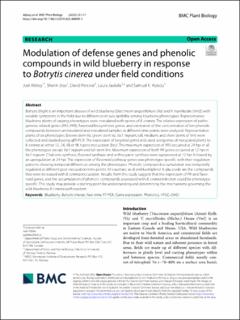| dc.contributor.author | Abbey, Joel | |
| dc.contributor.author | Jose, Sherin | |
| dc.contributor.author | Percival, David | |
| dc.contributor.author | Jaakola, Laura | |
| dc.contributor.author | Asiedu, Samuel K. | |
| dc.date.accessioned | 2023-10-04T07:15:37Z | |
| dc.date.available | 2023-10-04T07:15:37Z | |
| dc.date.created | 2023-03-12T13:44:42Z | |
| dc.date.issued | 2023-02-28 | |
| dc.identifier.citation | BMC Plant Biology. 2023, 23:117 1-16. | en_US |
| dc.identifier.issn | 1471-2229 | |
| dc.identifier.uri | https://hdl.handle.net/11250/3093996 | |
| dc.description.abstract | Botrytis blight is an important disease of wild blueberry [(Vaccinium angustifolium (Va) and V. myrtilloides (Vm))] with variable symptoms in the field due to differences in susceptibility among blueberry phenotypes. Representative blueberry plants of varying phenotypes were inoculated with spores of B. cinerea. The relative expression of pathogenesis-related genes (PR3, PR4), flavonoid biosynthesis genes, and estimation of the concentration of ten phenolic compounds between uninoculated and inoculated samples at different time points were analyzed. Representative plants of six phenotypes (brown stem Va, green stem Va, Va f. nigrum, tall, medium, and short stems of Vm) were collected and studied using qRT-PCR. The expression of targeted genes indicated a response of inoculated plants to B. cinerea at either 12, 24, 48 or 96 h post inoculation (hpi). The maximum expression of PR3 occurred at 24 hpi in all the phenotypes except Va f. nigrum and tall stem Vm. Maximum expression of both PR genes occurred at 12 hpi in Va f. nigrum. Chalcone synthase, flavonol synthase and anthocyanin synthase were suppressed at 12 hpi followed by an upregulation at 24 hpi. The expression of flavonoid pathway genes was phenotype-specific with their regulation patterns showing temporal differences among the phenotypes. Phenolic compound accumulation was temporally regulated at different post-inoculation time points. M-coumaric acid and kaempferol-3-glucoside are the compounds that were increased with B. cinerea inoculation. Results from this study suggest that the expression of PR and flavonoid genes, and the accumulation of phenolic compounds associated with B. cinerea infection could be phenotype specific. This study may provide a starting point for understanding and determining the mechanisms governing the wild blueberry-B. cinerea pathosystem. | en_US |
| dc.language.iso | eng | en_US |
| dc.publisher | BMC | en_US |
| dc.rights | Navngivelse 4.0 Internasjonal | * |
| dc.rights.uri | http://creativecommons.org/licenses/by/4.0/deed.no | * |
| dc.title | Modulation of defense genes and phenolic compounds in wild blueberry in response to Botrytis cinerea under field conditions | en_US |
| dc.title.alternative | Modulation of defense genes and phenolic compounds in wild blueberry in response to Botrytis cinerea under field conditions | en_US |
| dc.type | Peer reviewed | en_US |
| dc.type | Journal article | en_US |
| dc.description.version | publishedVersion | en_US |
| dc.rights.holder | © The Author(s) 2023 | en_US |
| dc.source.pagenumber | 1-16 | en_US |
| dc.source.volume | 23 | en_US |
| dc.source.journal | BMC Plant Biology | en_US |
| dc.identifier.doi | 10.1186/s12870-023-04090-5 | |
| dc.identifier.cristin | 2133279 | |
| dc.source.articlenumber | 117 | en_US |
| cristin.ispublished | true | |
| cristin.fulltext | original | |
| cristin.qualitycode | 2 | |

